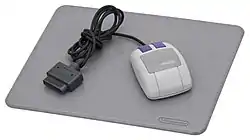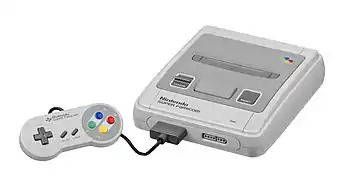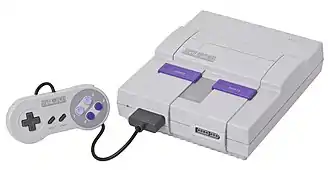Super NES Mouse
The Super NES Mouse, sold as the Super Famicom Mouse (スーパーファミコンマウス, Sūpā Famikon Mausu) in Japan, is a peripheral created by Nintendo for the Super Nintendo Entertainment System. It was first released on July 14, 1992 in Japan, in August of 1992 in North America, and in December 10, 1992 in Europe. Originally designed for use with the game Mario Paint, the Super NES Mouse was sold in a bundle with the game and included a plastic mouse pad. Soon after its introduction, several other titles were released with the Mouse support.
 The Super NES Mouse and Mousepad | |
| Developer | Nintendo |
|---|---|
| Manufacturer | Nintendo |
| Type | Video game console peripheral |
| Generation | Fourth generation |
| Release date | |
| Introductory price | $29.95 |
| Media | Input device |
| Related articles | Super Nintendo Entertainment System |
Although this device closely resembles and mimics the functionality of a two-button computer mouse, it was smaller than most computer mice of the time and had a significantly shorter cord than the standard Super NES controller.
List of compatible games
The Super NES Mouse was supported by many games during its lifetime, and even by the Super Game Boy accessory.[1] Certain games released after the Mouse—such as Super Mario All-Stars, Tetris & Dr. Mario, Yoshi's Island, and Kirby Super Star—display a warning message indicating that the mouse is incompatible with that game.
This is an incomplete list of games that support the accessory:
- Acme Animation Factory[1]
- Advanced Dungeons & Dragons: Eye of the Beholder[2]
- Alice no Paint Adventure (Japan only)
- Arkanoid: Doh It Again[3]
- Asameshimae Nyanko (Japan only)
- Bishoujo Senshi Sailor Moon S: Kondo wa Puzzle de Oshiokiyo! (Japan only)
- Brandish 2: Expert (Japan only)
- BreakThru!
- Cameltry (called On the Ball in North America and the UK)
- Cannon Fodder (PAL only)
- Dai-3-ji Super Robot Taisen (Japan only)
- Dai-4-ji Super Robot Taisen (Japan only)
- Dōkyūsei 2 (Japan only)
- Super Game Boy
- Doom (uses port 1)
- Dragon Knight 4 (Japan only)
- Dynamaite: The Las Vegas (Japan only)
- Farland Story 2 (Japan only)
- Fun 'n Games
- Galaxy Robo (Japan only)
- Hiōden: Mamono-tachi tono Chikai (Japan only)
- J.R.R. Tolkien's The Lord of the Rings: Volume 1
- Jurassic Park
- King Arthur's World
- Koutetsu no Kishi (Japan only)
- Koutetsu no Kishi 2: Sabaku no Rommel Shougun (Japan only)
- Koutetsu no Kishi 3: Gekitotsu Europe Sensen (Japan only)
- Kid Kirby (Unreleased)
- Lamborghini American Challenge
- Lemmings 2: The Tribes
- Lord Monarch (Japan only)
- Mario no Super Picross (Japan only)
- Mario Paint[1]
- Mario & Wario (Japan only)[4]
- Mario's Early Years: Fun with Letters
- Mario's Early Years: Fun with Numbers
- Mario's Early Years: Preschool Fun
- Mega lo Mania (PAL only)
- Might and Magic III
- Motoko-chan no Wonder Kitchen (Japan only)
- Nobunaga's Ambition
- Operation Thunderbolt[1]
- Pieces[5]
- Populous II: Trials of the Olympian Gods (PAL only)
- PowerMonger (PAL/Japan)
- Revolution X
- Sangokushi Seishi: Tenbu Spirits (Japan only)
- Sgt. Saunders' Combat! (Japan only)
- Shanghai - Banri no Choujou (Japan only)
- Shanghai III (Japan only)
- Shien's Revenge
- Sid Meier's Civilization
- SimAnt: The Electronic Ant Colony
- Snoopy Concert (Japan only)
- Sound Fantasy (unreleased)
- SpellCraft: Aspects of Valor (unreleased)
- Super Caesars Palace
- Super Castles (Japan only)
- Super Pachi-Slot Mahjong (Japan only)
- Super Solitaire
- T2: The Arcade Game[6]
- Tin Star[1]
- Tokimeki Memorial: Densetsu no Ni no Shita de (Japan only)
- Troddlers
- Utopia: The Creation of a Nation
- Vegas Stakes[1]
- Warrior of Rome III (unreleased)
- Wolfenstein 3D
- Wonder Project J: Kikai no Shounen Pino (Japan only)
- Zan II Spirits (Japan only)
- Zan III Spirits (Japan only)
- Zico Soccer (Japan only)
References
- "Let's Get Technical" (PDF). GamePro (66). IDG. January 1995. p. 14.
- "Ultimate Gaming Previews". Video Games: The Ultimate Gaming Magazine. No. 66. L.F.P., Inc. July 1994. p. 68.
- "Review Crew: Arkanoid: D.I.A.". Electronic Gaming Monthly. No. 102. Ziff Davis. January 1998. p. 155.
- "Edge Prescreen". Edge. No. 1. Future plc. October 1993. p. 44.
- Earth Angel (April 1995). "SNES Reviews - Pieces". GamePro. No. 69. IDG. p. 86.
- Scarry Larry (February 1994). "SNES Reviews - T2: The Arcade Game". GamePro. No. 65. IDG. pp. 108–9.


